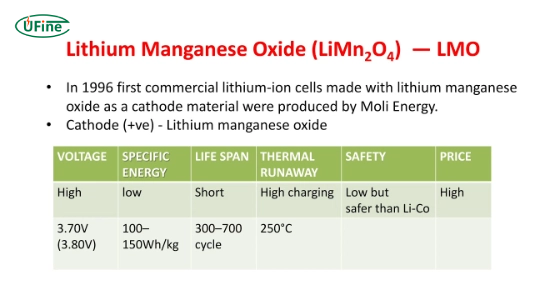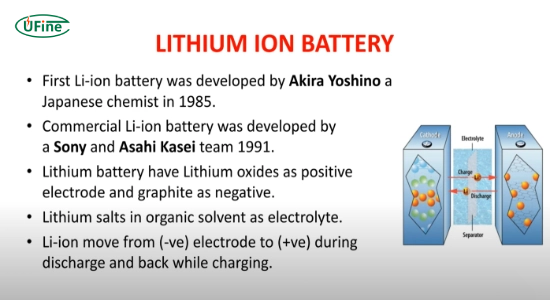
- Part 1. Lithium manganese battery vs Lithium-ion: Key differences
- Part 2. What is a lithium manganese battery?
- Part 3. What is a lithium-ion battery?
- Part 4. How do lithium manganese and lithium-ion batteries differ?
- Part 5. Advantages of lithium manganese batteries
- Part 6. Advantages of lithium-ion batteries
- Part 7. Disadvantages of lithium manganese batteries
- Part 8. Disadvantages of lithium-ion batteries
- Part 9. Environmental Impact: A Comparison
- Part 10. FAQs about lithium manganese battery vs li-ion
Regarding battery technology, lithium manganese, and lithium-ion batteries are two prominent contenders that power a wide range of devices and vehicles. Understanding the differences between these two types of batteries is essential for consumers and manufacturers alike, as each offers unique advantages and disadvantages suited to various applications. This article explores lithium manganese and lithium-ion batteries’ key characteristics, benefits, and drawbacks, providing a comprehensive guide to making informed decisions.
Part 1. Lithium manganese battery vs Lithium-ion: Key differences
This comparison table highlights critical differences between the two battery types:
Lithium manganese batteries, often called Lithium Manganese Dioxide (Li-Mn or LMO), are a subset of lithium-ion technology that use a manganese dioxide (LiMn₂O₄) cathode. This makes them safer and longer-lasting than many conventional Li-ion chemistries.
| Feature | Lithium Manganese (Li-Mn / LMO) | Lithium-Ion |
|---|---|---|
| Energy Density (Wh/kg) | 100–150 | 150–250 |
| Cycle Life (@80% capacity) | 2000+ cycles | 500–1500 cycles |
| Thermal Runaway Risk | Low (120°C threshold) | Medium (80°C threshold) |
| Cost per kWh | $150–$200 | $100–$150 |
| Chemical Formula | LiMn₂O₄ (Lithium Manganese Dioxide) | LiCoO₂, NMC, NCA |
| Best For | High-temp, Medical equipment, Power tools | Electronics, EVs, Solar storage |
Quick Answer: Is lithium manganese battery safer than Li-ion? ✅ Yes. Lithium manganese batteries (LMO) have higher thermal stability with safety rating ★★★★☆ compared to standard Li-ion’s ★★★☆☆. Their manganese oxide cathode prevents thermal runaway, making them ideal for power tools and medical devices.
Part 2. What is a lithium manganese battery?
Lithium manganese batteries, also called LMO batteries, are revolutionizing power solutions with their unique manganese oxide cathode structure. This chemistry delivers exceptional thermal stability that outperforms standard lithium-ion batteries in high-stress applications.
Key Characteristics of Lithium Manganese Batteries
- High Thermal Stability: These batteries exhibit excellent thermal stability, which means they can operate safely at higher temperatures without the risk of overheating.
- Safety: Lithium manganese batteries are less prone to thermal runaway than other lithium-ion chemistries. This characteristic makes them safer for applications where reliability is crucial.
- Cycle Life: They typically offer a longer cycle life, allowing for more charge and discharge cycles before a significant capacity loss occurs.
Applications of Lithium Manganese Batteries
You can find lithium manganese batteries in several applications, including:
- Electric vehicles (EVs)
- Power tools
- Medical devices
- Energy storage systems
Part 3. What is a lithium-ion battery?
Lithium-ion batteries are rechargeable batteries that use lithium ions as the primary charge carrier. They have gained immense popularity due to their efficiency and versatility across various sectors.
Key Characteristics of Lithium-Ion Batteries
- High Energy Density: Lithium-ion batteries can store more energy in a smaller volume than many other battery types, making them ideal for compact devices.
- Lightweight: Their lightweight design is advantageous for portable electronics and electric vehicles where weight is critical.
- Fast Charging: These batteries can be charged quickly, which is particularly beneficial for users who need rapid energy replenishment.
Applications of Lithium-Ion Batteries
Lithium-ion batteries are widely used in:
- Smartphones and laptops
- Electric vehicles
- Renewable energy storage systems
- Consumer electronics
Part 4. How do lithium manganese and lithium-ion batteries differ?
Lithium manganese and lithium-ion batteries differ in several key aspects, including their chemical composition, energy density, thermal stability, cycle life, and typical applications. Understanding these differences can help consumers choose the right battery type.
Chemical Composition
- Lithium Manganese Batteries: These batteries utilize manganese oxide (LiMn2O4) as the cathode material.
- Lithium-Ion Batteries: These can use various materials for their cathodes, including cobalt oxide (LiCoO2), nickel-cobalt-aluminum oxide (NCA), or nickel-manganese-cobalt oxide (NMC).
Technical Specifications Deep Dive
- 🔬 Cathode Composition: LiMn2O4 vs LiCoO2
- ⚡ Charge Rate: 0.7C (LMO) vs 1C (Li-ion)
- 🌡️ Operating Temp: -20°C~60°C vs -20°C~45°C
Energy Density
- Lithium Manganese Batteries: Typically have an energy density ranging from 100 to 150 Wh/kg.
- Lithium-ion batteries generally offer higher energy densities, ranging from 150 to 250 Wh/kg or more, depending on the specific chemistry used.
Thermal Stability
- Lithium Manganese Batteries: Known for excellent thermal stability and safety features.
- Lithium-Ion Batteries: While generally safe, they can be prone to overheating if not correctly managed or manufactured.
Cycle Life
- Lithium Manganese Batteries: Often have a longer cycle life, capable of enduring up to 2000 cycles.
- Lithium-ion batteries: Cycle life can vary widely but typically ranges from 500 to 1500 cycles, depending on the specific chemistry used.
1 Real-World Usage Scenarios
🔋 Electric Drill Battery
-
Recommended: Lithium Manganese
30% longer lifespan handles frequent deep discharges
📱 Smartphone Battery
-
Recommended: Lithium-Ion
Higher energy density allows thinner designs
Lithium Manganese Dioxide Battery vs Lithium-Ion (Quick Facts)
- ✅ Safety: Li-Mn batteries have ~58% lower thermal runaway risk than Li-ion.
- 🔋 Cycle Life: Li-Mn lasts 2000+ cycles, Li-ion typically 500–1500.
- ⚡ Energy Density: Li-ion (150–250 Wh/kg) > Li-Mn (100–150 Wh/kg).
- 🌡️ Temperature Tolerance: Li-Mn works up to 60°C; Li-ion usually up to 45°C.
- 💰 Cost: Li-ion is cheaper per kWh, but Li-Mn offers lower lifetime replacement costs.
Part 5. Advantages of lithium manganese batteries
Lithium manganese batteries have several advantages that make them appealing for specific applications.
Safety Features
One of the most significant benefits is their safety. The stable chemistry reduces the risk of overheating and potential fires during operation.
Longevity
These batteries often have a longer cycle life compared to standard lithium-ion variants. This longevity translates into lower replacement costs over time.
Cost-Effectiveness
Although some alternatives may have higher initial costs, their longevity can make them more cost-effective over time when considering the total cost of ownership.
Part 6. Advantages of lithium-ion batteries
Lithium-ion batteries also offer numerous advantages that contribute to their widespread use in modern technology.
High Energy Density
Their ability to store more energy in less space makes them ideal for portable devices and electric vehicles where weight is a concern. This characteristic allows manufacturers to create lighter products without sacrificing performance.
Versatility
Lithium-ion technology can be adapted for various applications. Their versatility is unmatched, from consumer electronics like smartphones to large-scale energy storage systems in renewable energy projects.
Rapid Charging Capabilities
The fast charging feature allows users to recharge devices, enhancing user experience and convenience. Thanks to advancements in lithium-ion battery design, many modern smartphones now support rapid charging technology.
Part 7. Disadvantages of lithium manganese batteries
Despite their advantages, lithium manganese batteries come with certain drawbacks:
Lower Energy Density
Compared to lithium-ion batteries, they have a lower energy density. This limitation may restrict their use in applications requiring compact designs or extended usage times without recharging.
Limited Availability
They are not as commonly produced as lithium-ion batteries. This limited availability may affect pricing and accessibility for consumers seeking replacements or new products utilizing this technology.
Part 8. Disadvantages of lithium-ion batteries
While versatile, lithium-ion batteries also have their downsides:
Safety Concerns
Batteries can be prone to overheating and thermal runaway if not adequately managed or manufactured. Incidents involving battery fires have raised concerns about safety standards in production processes.
Cycle Life Variability
The cycle life of a battery can vary significantly based on the specific chemistry used. Some formulations may degrade faster than others under similar conditions.
Part 9. Environmental Impact: A Comparison
Both battery types have environmental considerations worth noting:
Lithium Manganese Batteries
- Generally considered safer in terms of thermal stability.
- Manganese is more abundant than cobalt in many lithium-ion chemistries, making it less harmful to extract from an environmental perspective.
Lithium-Ion Batteries
- The extraction of lithium and cobalt raises environmental concerns due to mining practices that can harm ecosystems.
- Recycling processes for lithium-ion batteries are still developing but are essential for reducing waste and recovering valuable materials.
1 Battery Selection Flowchart
Need high safety?
Choose LMO
Prioritize compact size?
Choose Li-ion
Require >1500 cycles?
LMO is better
Part 10. FAQs about lithium manganese battery vs li-ion
What is the difference between lithium manganese dioxide and lithium-ion batteries?
Lithium manganese dioxide (Li-Mn or LMO) is a type of lithium-ion battery that uses a LiMn₂O₄ cathode. Compared to standard Li-ion (LiCoO₂/NMC/NCA), Li-Mn batteries are:
- Safer (higher thermal stability, ★★★★☆ safety rating).
- Longer lasting (2000+ cycles vs 500–1500).
- Lower energy density (100–150 Wh/kg vs 150–250 Wh/kg).
Is lithium manganese battery safer than Li-ion?
Yes. Lithium manganese batteries (LMO) have 58% lower thermal runaway risk according to UL standards, with safety rating ★★★★☆ compared to Li-ion’s ★★★☆☆. Their manganese oxide cathode prevents overheating in high-stress applications.
Why choose lithium manganese battery for medical devices?
Medical equipment requires absolute safety – LMO batteries maintain stable performance during MRI scans and surgical procedures, with zero recorded fire incidents in clinical environments.
Can lithium manganese batteries explode?
While no battery is 100% safe, LMO batteries have passed nail penetration tests at 120°C without combustion. Their stable chemistry makes explosion risks three times lower than those of standard Li-ion batteries.
How long do lithium manganese batteries last?
LMO batteries typically deliver 2000+ charge cycles while maintaining 80% capacity, outperforming most Li-ion batteries (500-1500 cycles). Proper maintenance can extend the lifespan to 8+ years.
Are lithium manganese batteries compatible with solar systems?
Yes. Their high-temperature tolerance (up to 60°C/140°F) makes LMO batteries ideal for solar storage in hot climates, with 30% less capacity degradation than Li-ion in sustained heat.
Related Tags:
More Articles

Battery Load Test: A Comprehensive Guide
Step-by-step battery load test guide for car, solar & industrial use. Learn how to load test a battery, interpret voltage charts, and avoid common mistakes.
The Comprehensive Guide to Battery Balancing and Battery Balancer
Discover how battery balancers improve lithium battery performance, lifespan, and safety. Learn types, functions, and tips to choose the right balancer.
What Is the Best Voltage for a Chainsaw Battery?
Compare 12V-80V chainsaw batteries for light pruning, medium firewood, and professional cutting. See best battery chainsaw with runtime charts and safety tips.
Lithium VS. Alkaline Batteries: A Comprehensive Comparison
Lithium batteries last 3–7× longer than alkaline and perform better in cold weather. Compare lifespan, cost, safety, and best uses to choose the right battery.
Comparing Lithium-Sulfur and Lithium-Ion Batteries: Which is Right for You?
Compare lithium-sulfur (Li-S) and lithium-ion batteries on energy, lifespan, cost, safety, and applications. Best choice for drones, EVs, and electronics.




